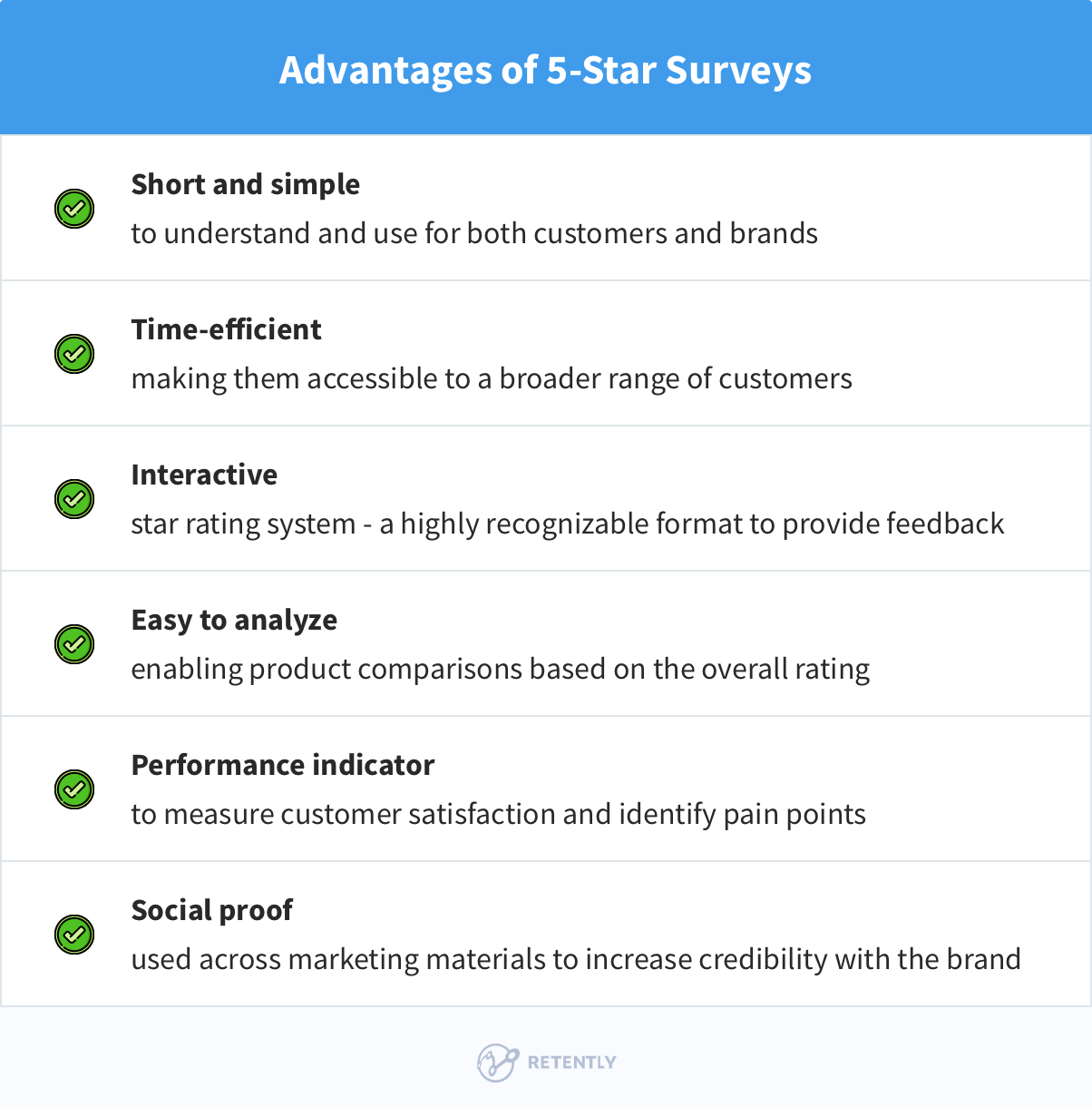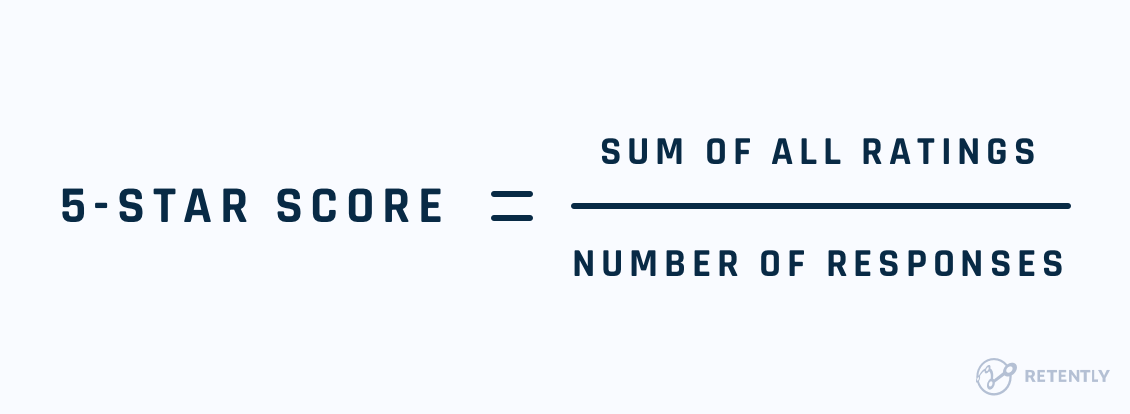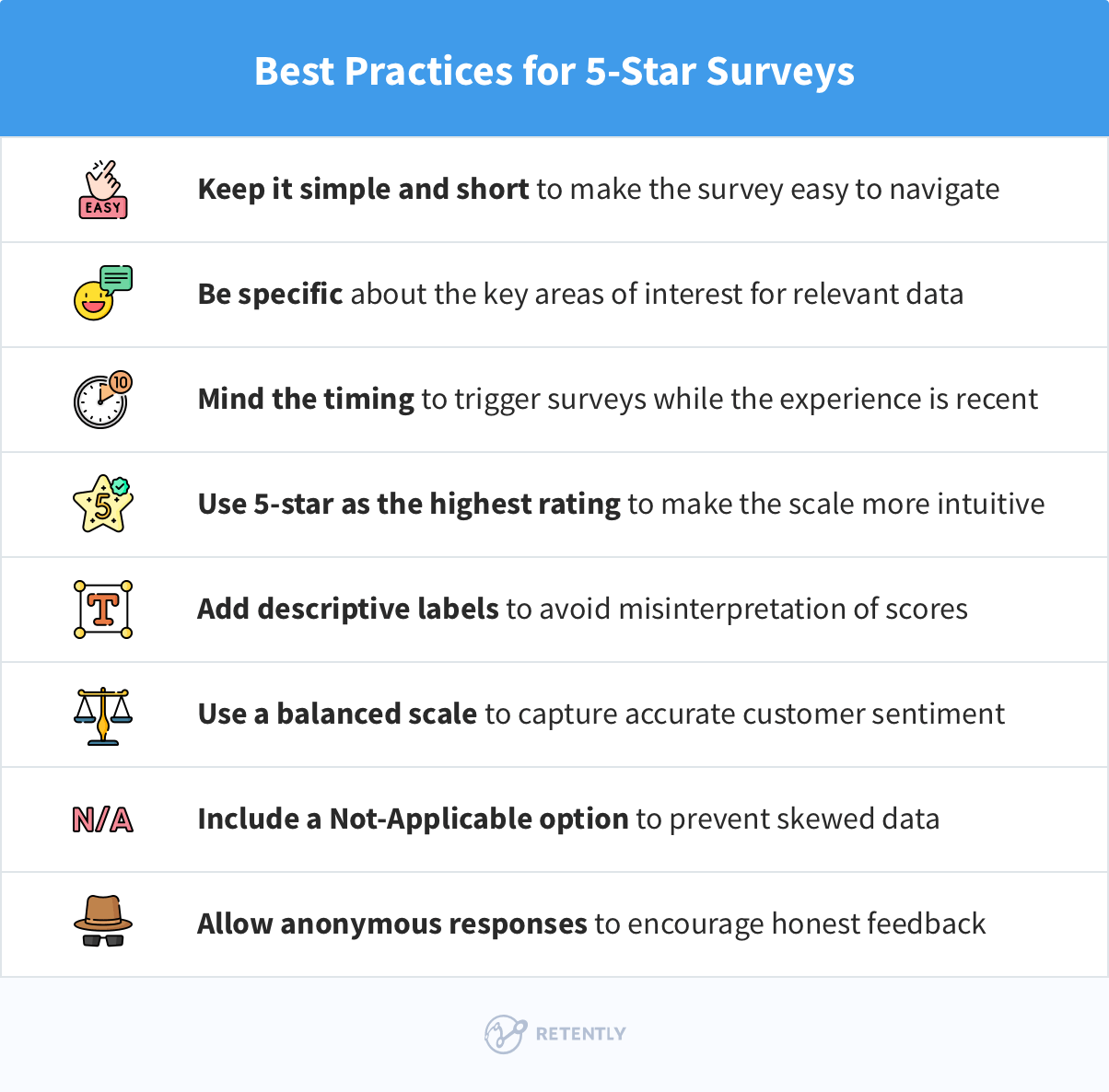Table of Contents
- Key Takeaways
- What Is a 5-Star Survey?
- Where Do You See 5-Star Surveys?
- When to Trigger 5-Star Surveys?
- Advantages and Disadvantages of 5-Star Surveys
- Labeling 5-Star Survey Ratings
- How Is the 5-Star Score Calculated?
- What Is a Good 5-Star Score?
- Best Practices for 5-Star Surveys
- Start Measuring Customer Satisfaction With Retently
There is nothing more important for a business than understanding the level of satisfaction and overall attitude of its customers. While talking to every customer personally is almost impossible, CX surveys take this function on.
Still, although 71% of consumers expect a personalized experience, most of them are unwilling to spend time responding to an endless stream of questions. Hence, businesses come up with options to minimize the efforts of their customers to share opinions and suggestions.
The 5-star survey – a variety of the CSAT survey – is one of the quickest ways to gather customer feedback and gauge customer satisfaction. The 5-star rating system is widely recognized and understood by customers, making it a popular method to collect and analyze feedback, especially for ecommerce businesses.
In this article, we’ll explore what a 5-star survey is, how the 5-star score is calculated, how to shape an efficient star survey and its value for companies willing to improve customer experience. Whether you’re new to using 5-star surveys or looking to improve your existing approach, this article will equip you with the essential knowledge to capture meaningful customer feedback.
Key Takeaways
- Simple and familiar, 5-star surveys provide an easy way to gauge customer satisfaction and identify areas for improvement across various touchpoints.
- Deploy surveys after key interactions (post-purchase, after support, or service delivery) and through the right channels to capture timely and honest feedback.
- Adding follow-up questions to 5-star surveys helps uncover the why behind ratings, providing actionable feedback for meaningful improvements.
- Using neutral wording, offering anonymity, and providing “No opinion” options encourage honest feedback and reduce inflated or biased responses.
- Leverage insights from 5-star surveys to refine existing products, develop new offerings, and enhance service delivery based on real customer needs.
What Is a 5-Star Survey?
A 5-star survey is a customer feedback questionnaire that uses a 5-point rating scale to assess satisfaction with a product or service. The concept is simple: customers are asked to rate a product, service, or experience on a scale of 1 to 5 stars.
The specific meanings of the 5-star rating scale labels may vary depending on the survey, but in general, ⭐⭐⭐⭐⭐ represent excellent or outstanding performance, while ⭐ points to a poor experience. This type of customer satisfaction survey is widely used across various industries as it is quick to complete, and the scale is easy to interpret.
The question posed in a 5-star survey is usually worded in the following manner: “On a scale of 1 to 5, how would you rate your experience with us?”. Of course, there are variations, but the principle is the same. This question allows customers to provide a quick and straightforward assessment of their experience while also allowing businesses to collect valuable data and drive the necessary improvements based on the results.

Given its versatility, the 5-star rating system is widely used for CSAT since customers can rate different aspects of their experience and tackle a variety of scenarios.
So, what are some good survey questions to ask? Here are some additional examples of common 5-star survey questions:
- How would you rate the quality of our product?
- How would you rate the packaging of the product?
- How would you rate the cleanliness of our facilities?
- How would you rate the helpfulness of our staff?
- How would you rate the hotel amenities (pool, fitness center)?
- How would you rate the quality of the ordered food?
- How was the customer service you received?
Adding Context: Open-Ended Follow-Up Questions
Naturally, asking just one question isn’t enough as it provides no details about the rating. If a customer gave 1 star, you need to know why they are dissatisfied to take appropriate measures. That’s why following up with additional questions is crucial, as it helps capture actionable feedback to improve customer experience. The open-ended question should be worded based on the given score, allowing respondents to expand on their choice.
For instance:
- For High Ratings: “We’re glad you had a great experience! What did you love most?”
- For Low Ratings: “We’re sorry to hear that. Can you tell us what went wrong so we can improve?”
- Neutral Ratings:“Thanks for your feedback! How can we make your experience even better?”
The open-ended question is thus necessary to provide more context to the data and identify areas for improvement or potential competitive advantages. By asking customers what they like most about a product, brands can highlight these strengths in their marketing materials. At the same time, by inquiring about the disappointing aspects, they can deliver a better customer experience. Open-ended questions can also help to identify patterns and trends in the data that may not stand out with rating questions alone. That’s because they allow respondents to express opinions and feelings in a way that is not limited by the predefines scale of a rating question.
Tip: Just make sure the follow-up field is optional – some customers prefer to keep it simple.
Where Do You See 5-Star Surveys?
The 5-star surveys are popular among service providers such as hotels, restaurants, retailers, or medical care, as they allow quick assessments of customer satisfaction and the quality of rendered services.
So, you’ve definitely seen 5-star ratings everywhere! They’re a go-to feedback tool for many major platforms, including:
- Uber prompts riders and drivers to complete 5-star surveys after trips, allowing the company to monitor service quality and safety.
- Airbnb sends 5-star surveys to both hosts and guests post-stay to collect feedback on cleanliness, communication, and accuracy.
- Mobile Apps often use in-app 5-star survey prompts to gauge user satisfaction after completing a task or reaching a milestone.
These platforms thrive on 5-star feedback because it’s quick, familiar, and effective.
When to Trigger 5-Star Surveys?
Timing is everything when it comes to gathering meaningful feedback. Knowing when and where to ask for a 5-star rating can make the difference between valuable insights and ignored surveys.
The timing for sending 5-star surveys can vary depending on the type of sought feedback. However, since 5-star surveys can be filled in quickly, it’s best to send them right after specific interactions with the product or service in question: for example, after a customer completes a purchase to assess their user experience with the website, post-delivery, or after they contact your support to judge its effectiveness.
Still, there is a broader use for 5-star surveys, meaning you can send them regularly to track customer satisfaction levels over time and take appropriate action when you see any shifts. By consistently measuring customer satisfaction, brands can identify trends and patterns in customer feedback, allowing them to address any issues before they become liabilities. That can help build stronger relationships and drive growth in the long run.
While 5-star surveys can provide valuable feedback on individual experiences, they may not be the best tool for tracking overall customer satisfaction on an ongoing basis. A more effective approach is using Net Promoter Score surveys, as they provide a more complete picture of customer sentiment and allow for regular tracking and efficient benchmarking against industry standards.
B2B vs. B2C Use Cases
While 5-star surveys work for all types of businesses, B2B and B2C companies use them differently based on customer interactions.
For B2B:
- Surveys after onboarding or product demos help gauge client satisfaction.
- Post-project feedback ensures service quality meets expectations.
- Follow-ups after quarterly check-ins or renewals can highlight areas for improvement.
For B2C:
- Ideal after purchases, deliveries, or customer service chats.
- In-store feedback kiosks or QR codes on receipts invite instant reactions.
- In-app ratings for ecommerce and digital services capture real-time feedback.
Tip: Regardless of your industry, make sure surveys feel natural in the customer journey. Asking at the wrong time (like too soon after a purchase or long after a service) can lead to low engagement or inaccurate feedback.
Advantages and Disadvantages of 5-Star Surveys
Advantages
Many businesses favor 5-star surveys for their ease of use and simplicity. It’s no surprise why, given the numerous advantages they offer.
The main advantage of a 5-star survey is its intuitiveness. Instinctively, we know that “1 star” is very bad, and “5 stars” is very good, and in most cases, respondents don’t need additional explanations. Irrespective of the customer’s language, the 5-star rating is very easy to interpret.
The 5-star surveys are straightforward and quick to complete: respondents only have to select a star. They don’t need to write long responses and spend much time answering questions. This simplicity also makes 5-star surveys accessible to a broader range of customers, including those who may not feel comfortable providing text feedback. That can lead to higher response rates compared to complex questionnaires.
Similar to other types of customer satisfaction surveys, they can help identify areas of strength and flag areas for improvement, allowing companies to take actionable steps to enhance their offering.
The 5-star survey provides a quantitative measure of customer satisfaction. That can be particularly useful for tracking trends over time, allowing businesses to monitor their progress and adjust accordingly. The numerical data from 5-star surveys can be easily visualized and analyzed, providing necessary insights into customer experiences. The 5-star rating system also offers a benchmark for companies to compare their performance with the competition.
This type of customer feedback survey is also visually pleasing: instead of boring text, we’ve got bright stars that are easily processed by the eye.
Ecommerce businesses have increasingly adopted 5-star surveys as the most popular type of customer survey, and use the 5-star survey ratings as a key performance indicator. They have become a common feature of the online shopping experience, making it a recognizable format for customers to leave feedback. Ratings and product reviews are also openly displayed, providing social proof for potential buyers, thus increasing sales.

Disadvantages
As simple and easy-to-use 5-star surveys may seem, there are certain considerations to keep in mind.
The main disadvantage of 5-star surveys is the scale itself, namely the midpoint value, though opinions vary here. Psychologically people are not always willing to give very high or very low scores (or provide a score at all) unless their experience with your product/service truly impacted them positively or negatively. Frequently customers choose the midpoint value, in this case – 3 stars – to be neutral and avoid any repercussions. And it’s easier: no need to think much about it. Naturally, this doesn’t give much insight into customers’ actual attitudes and satisfaction levels.
Neutrality isn’t the only concern. It is one thing when customers have to assess a service that doesn’t involve human interaction, like when they download an image from a stock site or buy something online. But it’s entirely different when they have to score someone they personally dealt with while experiencing your product. According to Professor John Horton from New York University, passengers tend to give high scores to Uber drivers, even if they don’t like everything, fearing the drivers may be fined or fired. Who would want to be responsible for it?
Several studies have looked into how products and services are rated on popular platforms like Amazon, Airbnb, and Booking.com. They found that most ratings follow an extreme distribution pattern, meaning they tend to have either very high or very low ratings. For example, a study of 17 different platforms, including Amazon, found that 14 of them had extremely distributed ratings more than 50% of the time. While these ratings may not accurately reflect product quality, some consumers still find them helpful.
The interpretation of 5-star ratings can considerably vary across cultures due to differences in cultural norms and values. That is particularly relevant in the context of Hofstede’s cultural dimensions framework shown to influence consumer behavior, namely: power distance, individualism vs. collectivism, masculinity vs. femininity, uncertainty avoidance, long-term vs. short-term orientation, and indulgence vs. restraint. Hence, a 5-star rating may have different implications in different cultural contexts.
The 5-star rating scale is limited in the detail it can provide, as it only allows for a broad rating of the customer’s overall satisfaction. It’s up to the follow-up questions to dig deeper for context and more actionable feedback. This information can be crucial for addressing specific customer needs.
These types of surveys may also be limited in their scope. Since 5-star surveys rely mostly on transactional feedback, they may not cover all areas of a customer’s experience or broader aspects of business performance one may be interested in, such as loyalty and advocacy. Moreover, given its use as social proof, some companies may rely too much on the star rating and disconsider other factors impacting the customer experience.
In addition, sometimes respondents may not have all the information when they fill in the survey. For example, suppose a customer purchases an item from your store, everything seems to go smoothly, and he gives 5 stars. Later, he finds out that the item is out of stock, the card payment was declined, etc. Naturally, the customer is frustrated, but the score was already submitted, so there is no way to change it.
Still, it doesn’t mean that 5-star surveys don’t serve their purpose. Similar biases can also be applied to other survey types, so they are not unique to 5-star surveys. Yet, as long as you efficiently map your customer journey and trigger the corresponding survey for accurate results, these instances are reduced to a minimum.
Labeling 5-Star Survey Ratings
Despite their intuitive nature, 5-star surveys may still require additional clues or context. Providing rating labels would often help get more relevant and actionable feedback.
This option allows you to clarify the meaning behind each star rating, making it easier for respondents to accurately and consistently rate their experience. By using descriptive labels, you can ensure that everyone understands what each rating stands for.
Giving unambiguous labels is crucial to ensure effective communication. In some cases, survey creators shift the scores to a more positive side, leaving fewer options for negativity. For example, for many people very good and excellent is the same thing, while others may see the difference. So, a scale of poor – fair – good – very good – excellent isn’t balanced, as almost all scores are positive, and the calculated average will be distorted.
A widely spread practice is labeling only the endpoints of the scale, like 1 star = very poor and 5 stars = very good, leaving the other empty and open to respondents’ interpretation. It is strongly recommended to label all points to get accurate and relevant feedback.
These are some of the labels for a balanced scale:
- very poor – poor – fair – good – very good
- very poor – poor – average – good – excellent
- very little – little – some – much – very much
In short, when creating 5-star surveys, it is essential to keep the scale balanced and provide proper labeling to avoid score misinterpretation.
While the 5-star rating system is the most commonly used, some businesses opt for a variation ranging from 1-10 stars. The 1-10 star rating system has some advantages in terms of granularity but is generally less widely recognized and may be more challenging to use and interpret.
How Is the 5-Star Score Calculated?
The calculation of the 5-star score is simple: the total number of stars submitted by the respondents is divided by the number of ratings/responses.
Let’s explain it with an example. Suppose 60 customers responded to a 5-star survey and provided: ten ratings of 5 stars, twenty ratings of 4 stars, five ratings of 3 stars, fifteen ratings of 2 stars, and ten ratings of 1 star.
The 5-star score would be calculated by the formula:
(1*10)+(2*15)+(3*5)+(4*20)+(5*10)/60=3,1 (rounded to the nearest tenth).
The 5-star score of the respective company would be 3,1 out of 5 stars.

What Is a Good 5-Star Score?
While there is no hard and fast rule for a good 5-star score, brands can still use some general guidelines to interpret customer feedback.
A score of 5 stars points to an excellent experience and a highly satisfied customer with the product or service. It is a strong marker that the customer will likely return to repurchase. It’s the perfect time to ask for a public review or a referral.
While a 4-star rating may not be as exceptional as a 5-star, it means that the customer had a positive experience and is generally satisfied with the product. Still, there may be some slight adjustments needed. It’s a positive rating that implies the customer will likely consider the brand for future purchases.
Is 3 out of 5 stars good? A score of 3 stars is considered neutral and hints at an average experience and existing issues you must address. While a 3-star rating is not negative, brands should give due weight to the received feedback and use it to identify improvement opportunities. So, this is a great opportunity to dig deeper and learn what’s missing.
Scores below 3 stars express customer dissatisfaction and severe flaws on the brand’s side. A score of 2 stars may pinpoint a poor experience and a customer who is unlikely to return, while a score of 1 star is reserved for extremely negative experiences (for example, a defective product or a frustrating support interaction). This type of feedback requires immediate action.
This being said, a good star rating is considered anything between 4 and 5 stars (if you use the 1 to 5 rating scale). It speaks of a high level of satisfaction and a positive experience with the product, service, or business.
However, keep in mind that the perception of a good star rating depends on many factors, including the context, the industry standards, and the cultural background. For some industries, a 3-star rating may be good; for others, such as luxury goods, anything less than a 5-star may cause concern. For example, an acclaimed restaurant may have higher standards for a good rating than a repair shop.
Yet, to better understand customer needs and expectations, it’s essential to consider the context and the additional feedback customers provide rather than focusing solely on the rating.
Best Practices for 5-Star Surveys
Following particular guidelines is crucial to reap the benefits of 5-star surveys fully.
- Proper labeling of stars will help avoid misinterpretation of scores and ambiguity. Sometimes businesses decide to turn the scale upside down, meaning that “1 star” is excellent, and “5 stars” is very poor: this approach is counterintuitive. Add descriptive labels above the icons and customize them to fit your needs to improve your survey results’ accuracy and usefulness. Consider using a balanced scale with positive and negative ratings to better capture the customer’s overall sentiment.
- Use simple, short questions to make the survey easy to navigate and complete. Don’t merge questions just to make the survey shorter while confusing respondents. Remember, while it’s important not to overwhelm customers, your final goal is to ensure accurate results.
- Since the rating question alone doesn’t give enough insights into the whole picture, additional questions will help better understand the opinions behind the given score. Be specific and focus on key areas of interest, to craft relevant and actionable questions that provide insight into the customer experience. For a boost of ideas relevant to your use case, leverage the survey question generator.
- As mentioned before, sometimes it is hard to understand whether the given feedback is honest and accurate. In this case, allowing anonymous responses is a solution, as respondents will be more honest when they know no repercussions will follow.
- Timing is essential. You should trigger the 5-star survey right after an interaction with the product or service to get immediate feedback. That allows respondents to provide thoughts and opinions while the experience is still fresh in their minds. Yet, you can send 5-star surveys regularly to keep track of any shifts in satisfaction. The timing must be tailored to the specific needs of each business to ensure the best results.
- Incorporate the N/A option (Not Applicable) to tailor the star rating system. This option can be used when a question is irrelevant to the respondent, offering an alternative that will not skew the data.
- If you’re offering a reward for completing the survey, make it clear that feedback – positive or negative – is equally valued.
- Consider rotating the type of feedback you collect. Mix in 5-star surveys with other formats like NPS or CES to keep things fresh.

Start Measuring Customer Satisfaction With Retently
Getting immediate feedback from customers is crucial as it allows timely action and avoids churn. The 5-star surveys serve this purpose best as they are usually short and simple and can be sent immediately after interacting with your product or service.
Don’t settle for average customer satisfaction; allow Retently to help you deliver exceptional experiences that keep your customers returning for more. With our intuitive platform, you can easily collect and analyze customer feedback, identify areas for improvement, and track progress over time. Sign up today for a 7-day trial and upgrade to a 5-star experience!



































 Alex Bitca
Alex Bitca 

 Greg Raileanu
Greg Raileanu 

 Christina Sol
Christina Sol 
